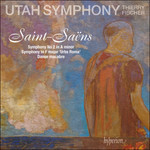|
Back
04/19/2019
“Works by Camille Saint-Saëns: Volume 2”
Camille Saint-Saëns: Symphony n° 2 in A minor, opus 55 [1] – Danse macabre, opus 40 [2] – Symphony in F major ‘Urbs Roma’ [3])
Madeline Adkins (concertmaster), Utah Symphony, Thierry Fischer (music director)
Recording: Abravanel Hall, Salt Lake City, Utah (September 22-23 [1], December 8-9, 2017 [3] and February 23-24, 2018 [2]) – 72’42
Hyperion CDA68212 (Distributed by PIAS) – Booklet in English, French and German

   
During the 2017-2018 season, Thierry Fischer’s ambitious mission was to record all of Camille Saint-Saëns’ five symphonies with Volume 1 being released last year. Available in North America next month, “Volume 2” is a strategical gem since these [symphonic] pieces were completed when Saint-Saëns was in his 20s, a ‘point of flux’ for the Parisian in a search of a true inner ear. Rich in their own case of development, the pieces are less visited which adds interest in this CD.
The Utah Symphony addresses spiritual and convincing logic throughout Symphony n° 2. Housed with a contrast of equations, Maestro Fischer takes great care in differentiating all four movements with the appropriate dimensions. The fugue is meticulously broken down into an essential layering of strings, acquiescing to balance and power while ceaselessly tugging at uneasy tension. This aggressive friction allows the following “Adagio” to be well contrasted with Utah Symphony’s statement seamlessly flowing down a river of innocuous innocence. When turning to the penultimate “Scherzo-Presto”, we hear copious amounts of sharp anxiousness continually knocking at the door; however, the pristine sudden shift in the middle compartment (1’57) gives lighter, semi-whimsy during the few opening bars, anticipating Le Rouet d’Omphale. Thierry Fischer goes to great lengths to build a plausible case study during the first three movements which aids in magnifying the unstoppable “Prestissimo”, filled with Mendelssohnian fortitude and bravado. This pixyish segment (at times reminiscent of Bizet’s Symphony in C major) holds grand allure, and it pulsates with perfection.
A musical juxtaposition cleverly moves the listener into un Saint-Saëns mature as Louise Vickerman quietly whittles through the twelve strokes of midnight with Madeline Adkins’ persuasive obbligato violin giving way to skeletal prominences during the Danse macabre. M. Fischer maneuvers through the composition with kid gloves and brings out important accentual effects with a precious amount of spookiness, such as Keith Carrick’s xylophone and Lissa Stolz’s oboe. Airwaves are filled with sinister legato waltz cadences with finely relayed contrapuntal exercises. Thierry Fischer whips up a well-articulation...it doesn’t get better than this. The tempo and morbid nuances will glue the listener to their seat.
The anonymous synonym given to Saint-Saëns’ Symphony in F major, ‘Urbs Roma’, [as mandated by judges of the Société Saint Cécile], can initially be seen as a royal treatment of classical kindness and friendly Beethovenian posturing during the opening movement, “Largo – Allegro”, particularly when hearing the loftiness within the horn section. Flutes and piccolo by the Mercedes Smith, Lisa Byrnes, and Caitlyn Valovick-Moore triumvirate feather the “Molto vivace” with benevolence in what could, otherwise, be construed as rather raw. Thierry Fischer gives meaning to the dirge-thickened circumlocution inside the “Moderato, assai serioso” that seems to meander into endless insipidness. We’re immediately given respite from time’s tedium by passing into the “Poco allegretto” and its six variations. This delightful depiction, captured by Utah Symphony, lifts forth the distinctly defined six variations: 1) formalized statement; 2) (2’16): anxiously forward and hammered thoughts; 3) (3’38): pious and softly contemplative arguments; 4) (6’49): brevis form with flute trimming, tagged by definitive pomp; 5) (7’25): rushed lower string lines below a woodwind melodic frame [akin to Le Rouet d’Omphale]; 6) (9’13): the final majestic thought: an eloquent oration, tempering the piece’s earlier wooliness…a thoughtful balletic-like close gives ‘Urbs Roma’ aimable fermeture.
Thierry Fischer has achieved finesse and adroitness throughout; however, the Danse macabre is the most indelible and arresting, due to the music itself. Satisfying.
Christie Grimstad
|